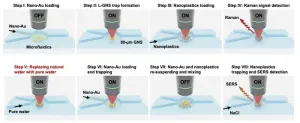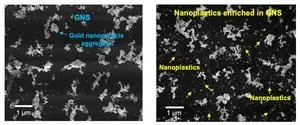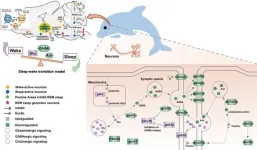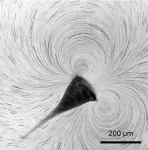AMHERST, Mass. – While the threat that microplastics pose to human and ecological health has been richly documented and is well known, nanoplastics, which are smaller than one micrometer (1/50th the thickness of an average human hair), are far more reactive, far more mobile and vastly more capable of crossing biological membranes. Yet, because they are so tiny and so mobile, researchers don’t yet have an accurate understanding of just how toxic these particles are. The first step to understanding the toxicology of nanoplastics is to build a reliable, efficient and flexible tool that can not only quantify their concentration in a given sample, but also analyze which specific plastics that sample contains.
An international team of scientists led by the University of Massachusetts Amherst recently announced in Nature Water the development of a new tool, known as the OM-SERS setup, which can do all of these things and can furthermore be used to detect particular nanoplastic concentrations and polymer types in solid samples, such as soils, body tissues and plants.
Plastic is an incredibly durable material, which can take up to 500 years to decompose. As plastic bottles, packaging and parts get older, teeny pieces of them break off. These microplastics have been found in every corner of the globe, from the top of Mount Everest to the depths of the Mariana Trench, and, according to recent reports, they are in many humans’ blood, brain and heart tissue.
If that’s not bad enough, each individual microplastic could theoretically be broken down into 1 quadrillion nanoplastic particles—which means that there are literally uncountable numbers of nanoplastics in our water, air and soils. These microplastics pose an as-of-yet unknown risk to the environment and to human health, and they’re altering ecosystems throughout the world.
“Because nanoplastics are so tiny, they have a much higher overall surface area and functional groups than microplastics, which means more of them can concentrate in water, soil and body tissues,” says Baoshan Xing, University Distinguished Professor of Environmental and Soil Chemistry at UMass Amherst’s Stockbridge School of Agriculture and one of the paper’s senior authors. “They travel more easily and can wind up in more places in the environment and in our bodies. And once in those places, they are more reactive and the chemicals and additives in them can more easily leach out into their surroundings.”
However, in order for toxicologists to begin to understand just how dire is the threat that nanoplastics pose, they first need to be able to count how many nanoplastics are in a sample and what specific types of plastic—each of which has a different chemical composition—are represented.
Xing, along with his co-senior authors, Jian Zhao and Xiaofeng Shi, professors at the Ocean University of China, and their team developed a method called “optical manipulation and surface-enhanced Raman scattering,” or OM-SERS, that involves lasers, gold and water. It is both the fastest, most efficient and reliable method that has yet been developed to count and analyze nanoplastics.
OM-SERS begins with a small water sample—just a few milliliters—into which Xing and Zhao place gold nanoparticles. Then they shoot the gold nanoparticles with a laser, and as the gold nanoparticles heat up, they attract the nanoplastics that are floating freely in the sample.
Once the various nanoplastic particles have all flocked to the gold stack, the team then rinses the sample with pure water, which flushes out the salts or any non-plastic debris—think tiny and prevalent soot particles or natural dissolved organic molecules that might be in the water. “What we have left behind are the plastic particles gathered around a gold center,” says Zhao. “We can then conduct a very, very sensitive analysis right in place, without moving the sample, that will tell us what kinds of plastics we have and in what concentrations.”
Not only can their method work with small samples, it can also be used to analyze nanoplastics in other matrixes. “We tested our OM-SERS system on samples gathered from a river, an ocean mariculture farm and a beach,” says Xing, “but, once the samples have been properly processed, it could work to test the concentration and types of nanoplastics in soil, plant tissues or our own bodies.”
Contacts: Baoshan Xing (US contact), bx@umass.edu
Jian Zhao (China contact), jzhao@ouc.edu.cn
Daegan Miller, drmiller@umass.edu
END
We know nanoplastics are a threat—this new tool can help us figure out just how bad they are
UMass Amherst leads international team of scientists in development of ultra precise, efficient and flexible technique for counting and analyzing nano-scale scourge
2025-04-01
(Press-News.org) April 1, 2025
ELSE PRESS RELEASES FROM THIS DATE:
Mpox could become a serious global threat, scientists warn
2025-04-01
Mpox has the potential to become a significant global health threat if taken too lightly, according to scientists at the University of Surrey.
In a letter published in Nature Medicine, researchers highlight how mpox – traditionally spread from animals to humans – is now showing clear signs of sustained human-to-human transmission.
Mpox is a viral infection caused by a virus that belongs to the same family as smallpox. The virus can cause a painful rash, fever, and swollen glands and, in some cases, lead to more serious illness. Mpox usually spreads through ...
Combination immunotherapy shrank a variety of metastatic gastrointestinal cancers
2025-04-01
A new form of tumor infiltrating lymphocyte (TIL) therapy, a form of personalized cancer immunotherapy, dramatically improved the treatment’s effectiveness in patients with metastatic gastrointestinal cancers, according to results of a clinical trial led by researchers at the National Institutes of Health (NIH). The findings, published April 1, 2025 in Nature Medicine, offer hope that this therapy could be used to treat a variety of solid tumors, which has so far eluded researchers developing cell-based ...
Newborn warty birch caterpillars defend the world’s smallest territory
2025-04-01
Real estate is precious. Some creatures defend territories extending over several kilometres, but when Jayne Yack (Carleton University, Canada) encountered miniature newborn warty birch caterpillars (Falcaria bilineata) she wondered if she might have discovered one of the world’s smallest, and youngest, territorial critters. ‘We had noticed that tiny warty birch caterpillars produced vibrations’, says Yack, who first encountered the feisty little creatures in 2008. She also noticed that the tiny caterpillars – 1 to 2 mm long – reside in solitude on birch leaves, making her speculate whether they ...
Exposure to air pollution in childhood is associated with reduced brain connectivity
2025-04-01
A new study led by the Barcelona Institute for Global Health (ISGlobal), a centre supported by the "la Caixa" Foundation, has found that children exposed to higher levels of air pollution in early and mid childhood have weaker connections between key brain regions. The findings, published in Environment International, highlight the potential impact of early exposure to air pollution on brain development.
The research showed reduced functional connectivity within and between certain cortical and subcortical brain networks. These networks are systems of interconnected brain structures that work together to perform different cognitive functions, such as thinking, perceiving and controlling ...
Researchers develop test using machine learning to help predict immunotherapy response in lymphoma patients
2025-04-01
LOS ANGELES — Researchers with City of Hope, one of the largest and most advanced cancer research and treatment organizations in the United States, with its National Medical Center in Los Angeles ranked among the nation’s top 5 cancer centers by U.S. News & World Report, and MSK have created a tool that uses machine learning to assess a non-Hodgkin lymphoma (NHL) patient’s likely response to chimeric antigen receptor (CAR) T cell therapy before starting the treatment, according to study results published today in Nature Medicine.
CAR T cell therapy ...
New UNSW research reveals dramatically higher loss of GDP under 4°C warming
2025-04-01
New projections by the UNSW Institute for Climate Risk & Response (ICRR) reveal a 4°C rise in global temperatures would cut world GDP by around 40% by 2100 – a stark increase from previous estimates of around 11%.
The recently-published analysis fixes an oversight in the current economic model underpinning global climate policy, toppling previous carbon benchmarks.
The results support limiting global warming to 1.7 °C, which is in line with significantly faster decarbonisation goals like the Paris Agreement, and far lower than the 2.7°C supported ...
Discovery of Quina technology challenges view of ancient human development in East Asia
2025-03-31
While the Middle Paleolithic period is viewed as a dynamic time in European and African history, it is commonly considered a static period in East Asia. New research from the University of Washington challenges that perception.
Researchers discovered a complete Quina technological system — a method for making a set of tools — in the Longtan site in southwest China, which has been dated to about 50,000 to 60,000 years ago. Quina technology was found in Europe decades ago but has never before been found in East Asia.
The team published its findings March ...
Whales and dolphins sleep by turning off one half of their brains at a time; scientists discover more about the genes and pathways that enable this phenomenon
2025-03-31
Whales and dolphins sleep by turning off one half of their brains at a time; scientists discover more about the genes and pathways that enable this phenomenon.
####
Article URL: https://plos.io/4c9g5gm
Article Title: Evolution of canonical circadian clock genes underlies unique sleep strategies of marine mammals for secondary aquatic adaptation
Author Countries: China
Funding: This work was supported by the National Key Research and Development (R&D) Program of China (grant no. 2022YFF1301600) to G.Y. & S.X., the Key Project ...
A new clue to how multicellular life may have evolved
2025-03-31
Life emerged on Earth some 3.8 billion years ago. The “primordial soup theory” proposes that chemicals floating in pools of water, in the presence of sunlight and electrical discharge, spontaneously formed organic molecules. These building blocks of life underwent chemical reactions, likely driven by RNA, eventually leading to the formation of single cells.
But what sparked single cells to assemble into more complex, multicellular life forms?
Nature Physics published a new insight about a possible driver of this key step in evolution — the fluid ...
ALL ALS consortium launches website to advance ALS research
2025-03-31
ALL ALS Consortium Launches Website to Advance ALS Research
The Access for All in ALS (ALL ALS) Consortium announced the launch of its official website, creating a central hub for information about its initiatives and clinical research studies. ALL-ALS.org is designed to inform and engage researchers, clinicians, and current and prospective study participants.
The ALL ALS Consortium formed in fall 2023 with funding from the National Institutes of Health (NIH). The consortium consists of 35 clinical sites in the United States and Puerto Rico, led by researchers at Barrow Neurological Institute in Phoenix, Arizona and Massachusetts ...
LAST 30 PRESS RELEASES:
ASH 2025: Antibody therapy eradicates traces of multiple myeloma in preliminary trial
ASH 2025: AI uncovers how DNA architecture failures trigger blood cancer
ASH 2025: New study shows that patients can safely receive stem cell transplants from mismatched, unrelated donors
Protective regimen allows successful stem cell transplant even without close genetic match between donor and recipient
Continuous and fixed-duration treatments result in similar outcomes for CLL
Measurable residual disease shows strong potential as an early indicator of survival in patients with acute myeloid leukemia
Chemotherapy and radiation are comparable as pre-transplant conditioning for patients with b-acute lymphoblastic leukemia who have no measurable residual disease
Roughly one-third of families with children being treated for leukemia struggle to pay living expenses
Quality improvement project results in increased screening and treatment for iron deficiency in pregnancy
IV iron improves survival, increases hemoglobin in hospitalized patients with iron-deficiency anemia and an acute infection
Black patients with acute myeloid leukemia are younger at diagnosis and experience poorer survival outcomes than White patients
Emergency departments fall short on delivering timely treatment for sickle cell pain
Study shows no clear evidence of harm from hydroxyurea use during pregnancy
Long-term outlook is positive for most after hematopoietic cell transplant for sickle cell disease
Study offers real-world data on commercial implementation of gene therapies for sickle cell disease and beta thalassemia
Early results suggest exa-cel gene therapy works well in children
NTIDE: Disability employment holds steady after data hiatus
Social lives of viruses affect antiviral resistance
Dose of psilocybin, dash of rabies point to treatment for depression
Helping health care providers navigate social, political, and legal barriers to patient care
Barrow Neurological Institute, University of Calgary study urges “major change” to migraine treatment in Emergency Departments
Using smartphones to improve disaster search and rescue
Robust new photocatalyst paves the way for cleaner hydrogen peroxide production and greener chemical manufacturing
Ultrafast material captures toxic PFAS at record speed and capacity
Plant phenolic acids supercharge old antibiotics against multidrug resistant E. coli
UNC-Chapel Hill study shows AI can dramatically speed up digitizing natural history collections
OYE Therapeutics closes $5M convertible note round, advancing toward clinical development
Membrane ‘neighborhood’ helps transporter protein regulate cell signaling
Naval aviator turned NPS doctoral student earns national recognition for applied quantum research
Astronomers watch stars explode in real time through new images
[Press-News.org] We know nanoplastics are a threat—this new tool can help us figure out just how bad they areUMass Amherst leads international team of scientists in development of ultra precise, efficient and flexible technique for counting and analyzing nano-scale scourge





